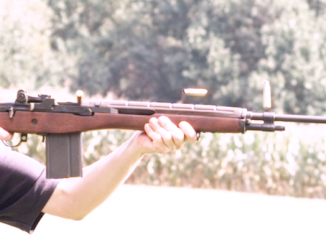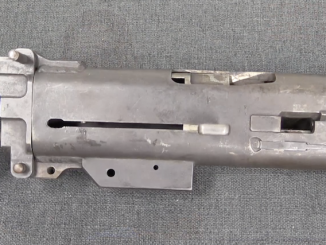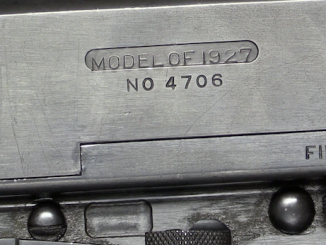Today I am running an early-configuration M1 Carbine through my standardized Pistol-Caliber Carbine course of fire. This consists of a selection of cool target systems from MOA Targets – an 8-plate dueling tree, a mini-Mozambique, and a Redneck Star. These will serve to test target transitions, precision shots, and moving targets respectively.
I expected the Carbine to do well, and it did. These targets are always a challenge with iron sights, as they are relatively small and blend into the background (especially the mini-Mozambique) – but the M1 Carbine has good aperture sights and a nice long sight radius. The 15-round magazines (and lack of automatic hold open) are also a limitation, but I was able to successfully clear the course without expending all of the 45 rounds I had available. My final time was 120.83 seconds, clearing the course successfully. Note that I did accidentally skip one of the plates on my first run through the dueling tree, but also double-engaged the static target after reloading. I figure these two basically cancel each other out.




I guess this means that the M1 Carbine was always intended for “close” encounters (SMG to lower rifle range). It’s easier to swing around than a full-size M1 Garand but more likely to hit something and kill it at 50 yards than a Colt 1911 (NEVER BRING A PISTOL INTO A RIFLE FIGHT). I could be wrong.
“(…)M1 Carbine was always intended for “close” encounters (SMG to lower rifle range)(…)”
According to https://www.forgottenweapons.com/light-rifle-program/
…requirements(…)were(…)effective range of 300 yards…
My M-1 carbine (Alpine commercial) was my first centerfire rifle. It’s handy, it’s accurate, it’s fun to shoot.
Daweo – This was a time when the effective range of the standard rifle – the M1 Garand – was rated as 500 yards (the manuals said 460 meters by the time I encountered it in 1970), so lower rifle range sounds correct.
Good thing Ian was wearing a helmet! Fun watching the empty brass bounce of the helmet instead of his forehead! The M1 carbine does not exactly reward “south-paws!”
The 300 meter effective range requirement is well known, and is why the hoary old .32 Winchester SL cartridge was slated as the basis for the “light rifle” program instead of any pistol cartridges like, say, 9mm or .45acp or even .38 Super.
Cool that Ian found an original WWII set-up carbine with the early flip two-range sights and no bayonet lug for the test. A local shooting club has a so-called “Carbine rattle battle” once a year, in which participants start at long range and fire and move toward the target. I don’t remember the exact course of fire.D
“Carbine Battle Rattle” sounds fun. It also is what my 1943 carbine actually sounds like (the top handguard is kind of loose, and rattles).
The only quibble I have is that it is a bit of a stretch to call .30 Carbine a “pistol caliber”. Yes you can compare it to the .44 Magnum (invented in the mid-1950s) but like I said: a bit of a stretch.
.30 Carbine is 7.62×33 in metric which makes it similar in length and ballistics to .357 Magnum (from a 16″ barrel) and the cartridge is straight sided so it’s more like a Magnum pistol round than a cut down rifle cartridge like 7.92×33 kurz or 7.62.39 M43
.32 French Very Longue 😉
“(…) stretch to call .30 Carbine a “pistol caliber””
There was actually attempt of building revolver firing during WW2 https://military.wikia.org/wiki/.30_Carbine
In 1944, Smith & Wesson developed a hand-ejector revolver to fire .30 Carbine. It went through 1,232 rounds without incident. From a four-inch (102 mm) barrel, it launched the standard GI ball projectile at 1,277 ft/s (389 m/s), producing a large average group of 4.18 inches (106 mm) at 25 yards (23 m); the military decided not to adopt the revolver.
It did worked and produced thunderous effect to shooter so it was not adopted.
It was a warmed-over cartridge intended for an early 1905 Winchester self-loading rifle, .32 SL.
https://patents.google.com/patent/US681481
While the rifle was 7-lbs. and blowback operated, with a handy take-down feature, the cartridge was insufficient for hunting medium-sized game, but it was accurate out to 300-yards or so, and Townsend Whelen thought it would work for “rapid fire target shooting,” which is what the army Ordnance apparently envisioned too… As noted by some observers in earlier comment threads, it was swiftly superseded in civilian use by the .351 SL for the model 1907 self-loading/ blowback-operated rifle, which found favor as a police rifle up until the early 1950s. As one observer here, eon, noted: the .351 might have served as a basis for a new “light rifle cartridge” instead of the .32 SL but for the .30 cal. requirement to ease ammunition manufacture in U.S. facilities, I’d wager. Similarly, the hoary old .30-30 centerfire deer cartridge might have served as a basis for a true “intermediate power cartridge” but the resultant weapon to fire it would undoubtedly have exceeded the rigid weight requirement that polo-playing, pipe-smoking Col. Rene Studler insisted would be the “sweet spot” for reduced weight for the overburdened ammo carrier or weapon crewman, and as a pistol replacement for cooks, drivers, and other rear-echelon/”Etappenschweine” distant from the “front” but possibly coming under fire from parachutists, or a mechanized thrust, quite unlike the first Word War. A thread might be drawn from .32-40 through .32 SL to .30 SL and its final adoption as .30 carbine.
Arguably it was Soviet technicians who invented magnum pistol cartridges, namely the 7.62x25mm, but in U.S. developments, it was Idaho rancher Elmer Keith and various U.S. law enforcement officials who hot-rodded the .38 Special into the .357 magnum in the 1930s.
“(…) Similarly, the hoary old .30-30 centerfire deer cartridge might have served as a basis for a true “intermediate power cartridge”(…)”
It did provoked development of .30 Remington Autoloading cartridge which was rimless (better fitting box magazines) and therefore might be easier.
Evidently not many people are aware that the French Army bought and used 1907 Winchester Self Loading rifles with 10 and 15 round detachable magazines in the later stages of WW1 against German trenches. This makes the 1907 and the .351 cartridge true contenders for the first real “assault” rifles used in war. I read a speculative thought somewhere that the M1 carbine should have been developed to use the .351 WSL and with the gas system the cartridge could have been improved over the straight blowback system of the 1907.